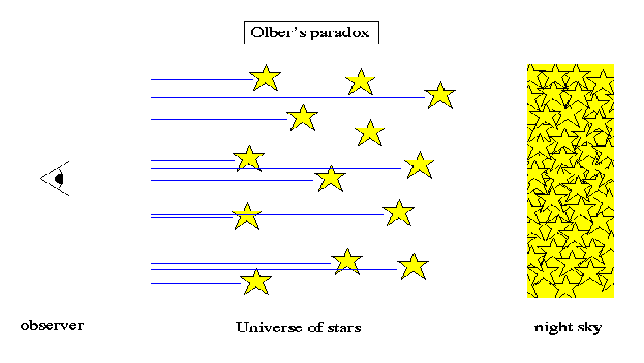The Universe was once assumed to be infinite, unchanging, eternal. In this case, whichever direction you are looking when looking up at the night sky, every line of sight should end on the surface of a star, and the night sky should be as bright as the Sun. After all, if you move the Sun twice as far away from us, we will individually receive one quarter as many photons, but the Sun's angular area against the sky background will also have now dropped to a quarter, and the brightness per unit area of the Sun will be constant. With infinitely many stars, every element of the sky background should have a star, and the entire heavens should be as bright as an average star like the Sun.

Some possible explanations of Olber's paradox have included:
-
There's too much dust to see the distant stars.
-
The Universe has only a finite number of stars.
-
The distribution of stars is not uniform. So, for example, there could be an infinity of stars,
but they hide behind one another so that only a finite angular area is subtended by them. -
The Universe is expanding, so distant stars are red-shifted into obscurity.
-
The Universe is young. Distant light hasn't even reached us yet.
The first explanation is wrong, since the dust will absorb energy and eventually heat up and re radiate that energy, eventually appearing to be the same temperature as the stars.
As for the second, while the number of stars may not be infinite, it is as close to infinite as we need for Olber's paradox to be real, since there are enough stars by our calculation to light up the entire night sky.
The third explanation might be partially correct. If the stars and galaxies are distributed irregularly then there could be large patches of empty space, and the sky could appear dark except in small areas.
In fact the final two possibilities are each correct and partly responsible We live inside a spherical shell of "Observable Universe" which has radius measured in lightyears equal to the lifetime of the Universe Objects more than about 13.7 thousand million years old (the latest figure) are too far away for their light ever to reach us.
